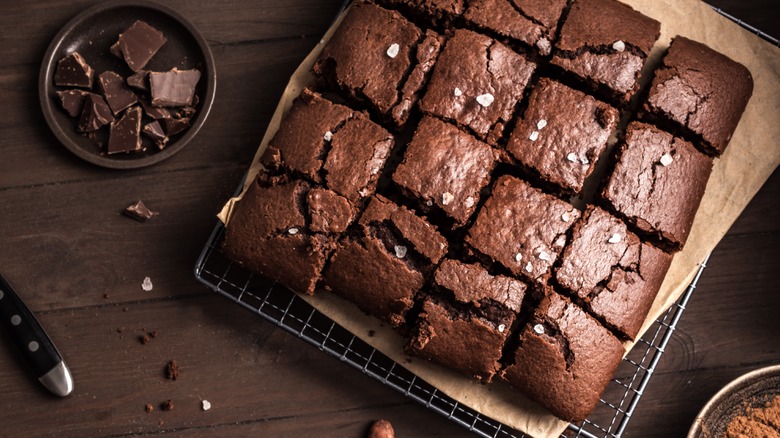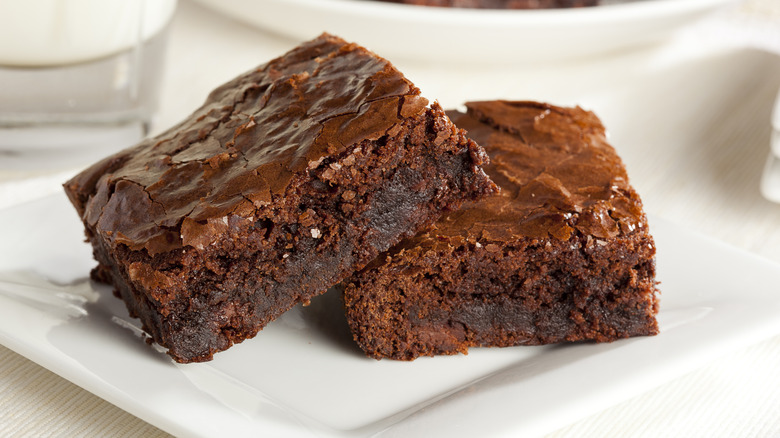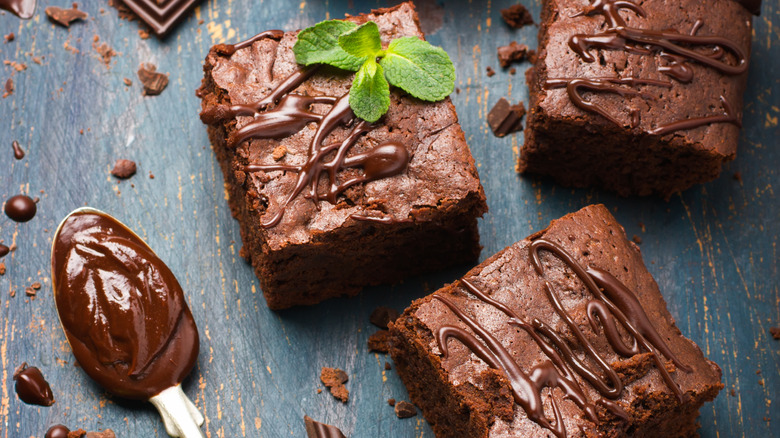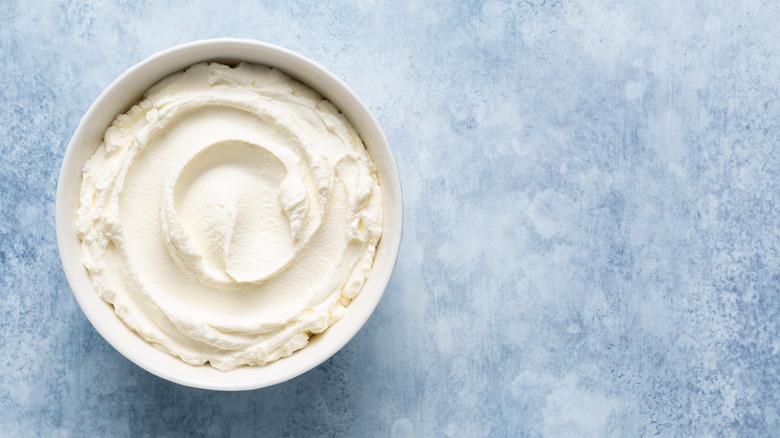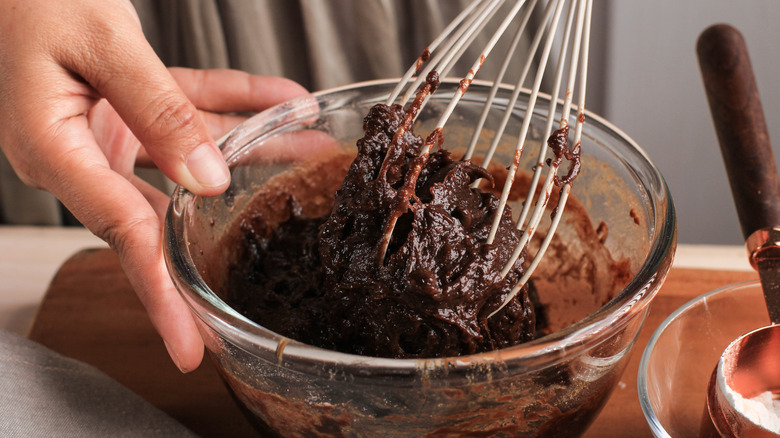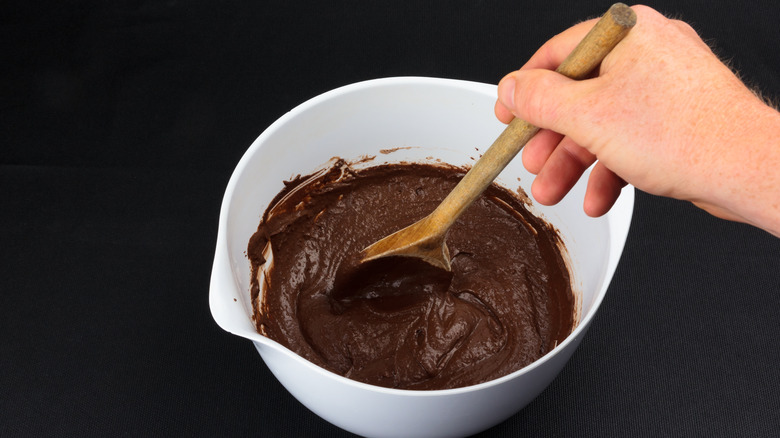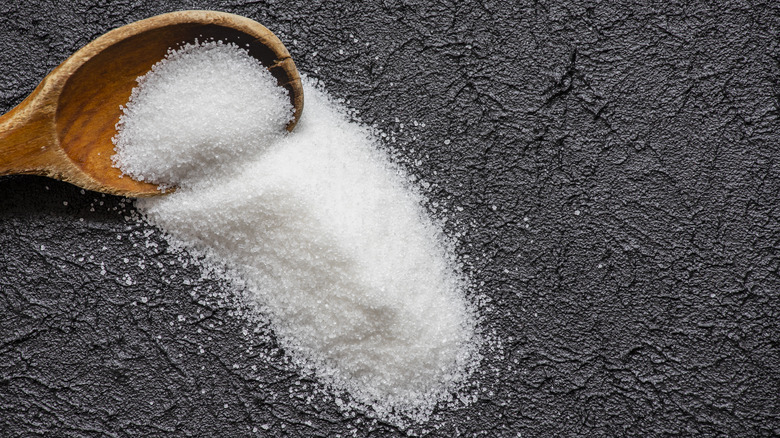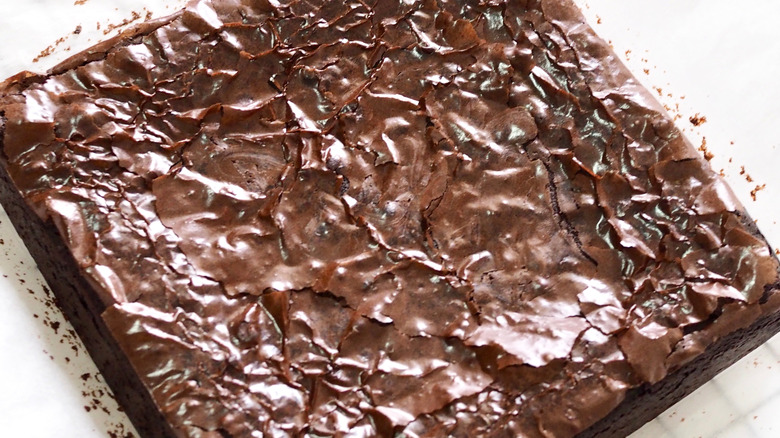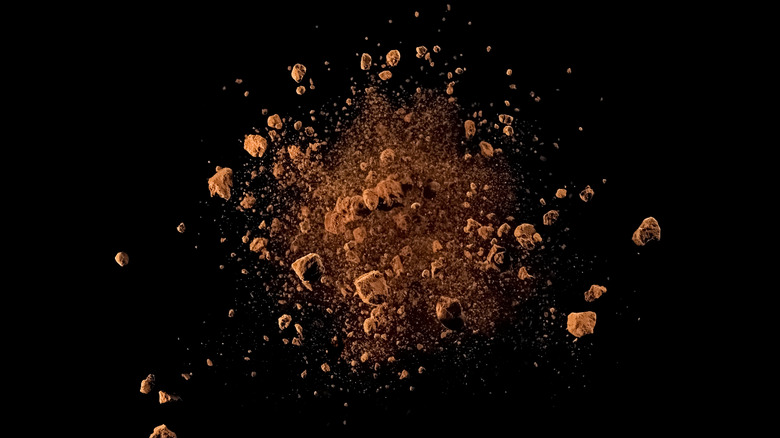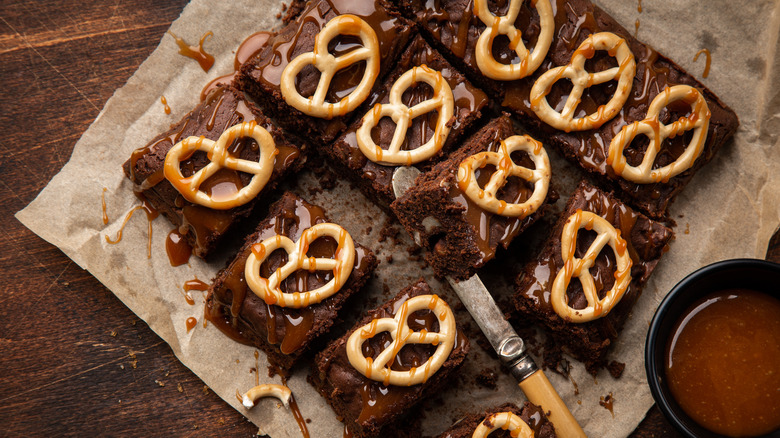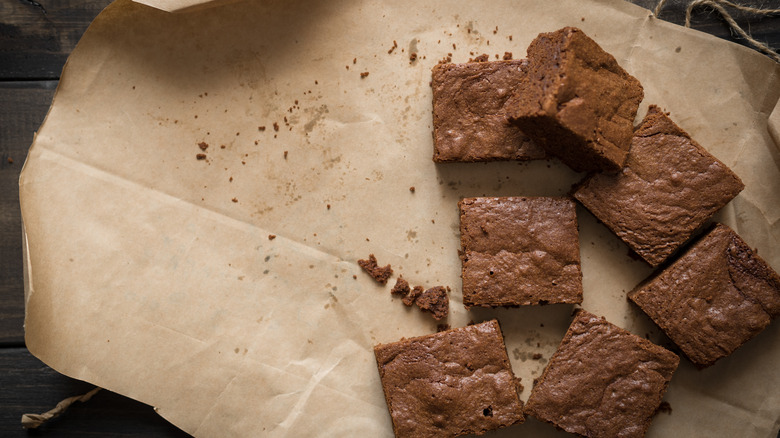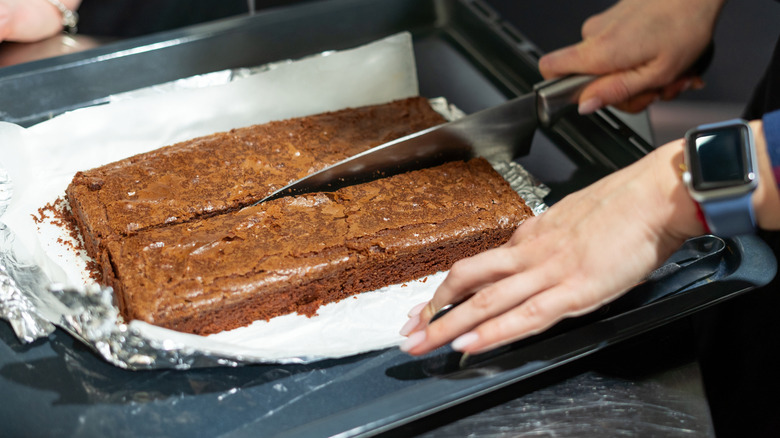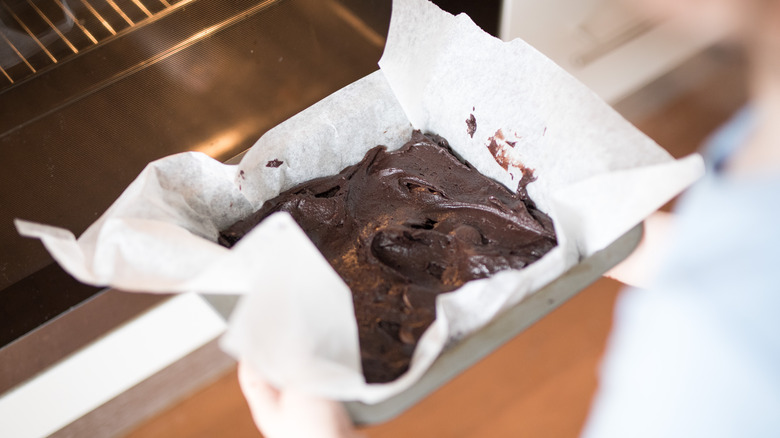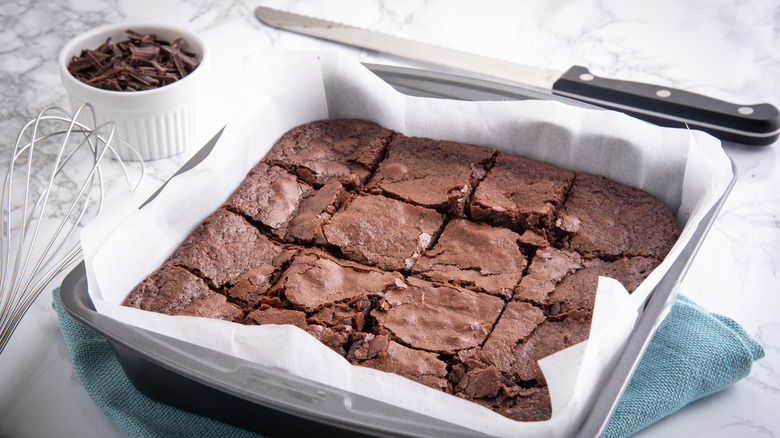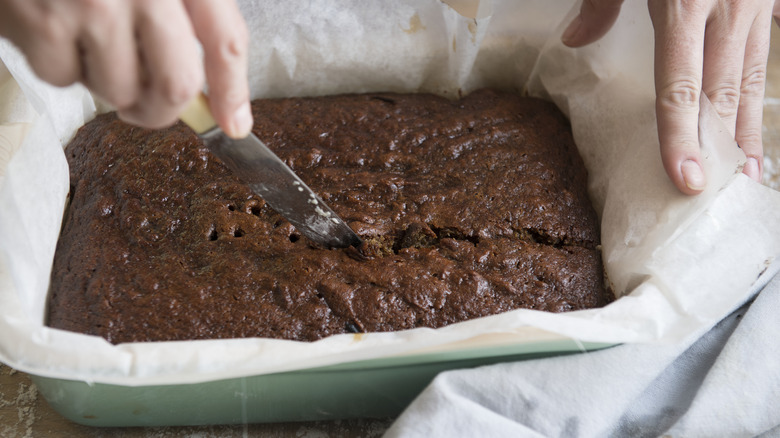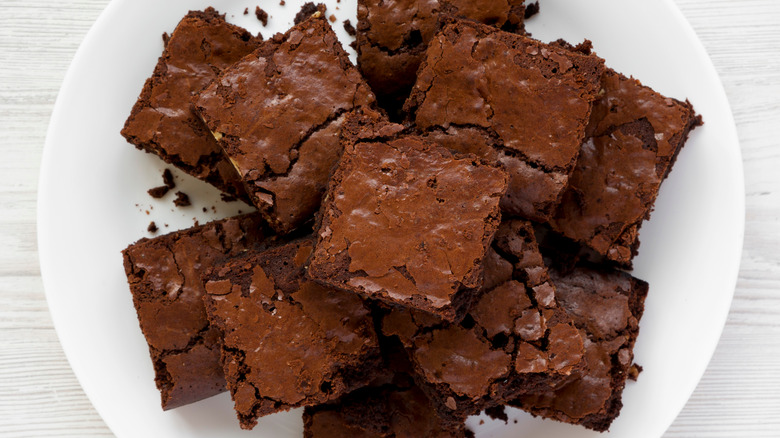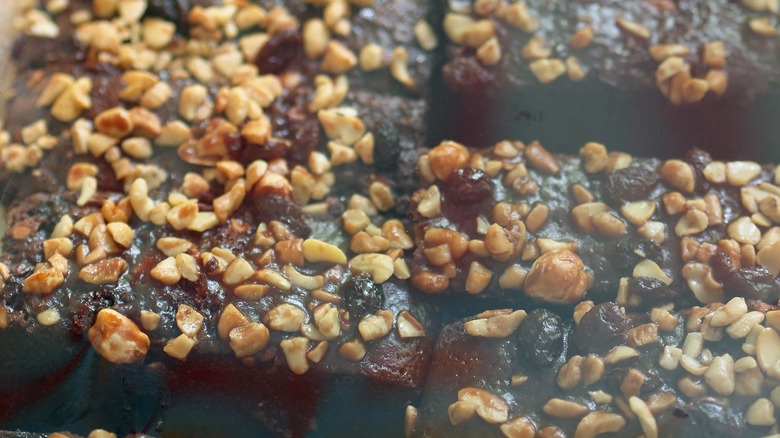16 Mistakes You're Making With Brownies
Borwnies are a highly welcoming dessert. The warm, inviting flavor of chocolate combined with the softness of a plush, cake-like texture of this dessert makes it one of America's favorites.
One of the origin stories for the brownie was a 1905 home cook who adapted a cookie recipe to fit in a rectangular pan (via The Nibble). These desserts were called "bar cookies" because the brownie was not eaten with a fork like a cake. Other origin stores include a chef dropping chocolate into a biscuit recipe or a home cook who forgot to add baking powder to her chocolate cake.
Brownies are a deceptively easy dessert; you'll need to add your oil, eggs, and water for a boxed mix. But, there are often many micro-mistakes that bakers make along the way that can take a brownie from incredible to disappointing in a matter of minutes. To make the best brownies, it's essential to avoid making some common mistakes.
1. Using the wrong recipe for the texture you desire
There are two different brownie "camps." The first type is fudgy, which is molten, dense, and moist. These brownies often fit the category of chewy brownies, which are compact and have less give when you bite into them. The other is a cake-like brownie, which is airier and drier. The recipe for these two types of brownies has some minute differences that alter the texture of the finished product.
Fudgy brownie recipes often contain more egg and moist ingredients, while cakey brownies have more traditional cake-based ingredients like butter, flour, and sugar. These brownies get their texture from creaming the butter and sugar together at high speeds until enough air has been beaten into the batter (via Land o' Lakes). Both cake and fudge brownies may include melted chocolate for added richness. If you're using a brownie recipe, you need to be sure it is the right recipe for your ideal texture.
2. Omitting complementary ingredients
There are a lot of flavors you can play with when it comes to brownies. Coffee is one of our favorite ingredients to include in a brownie. Mocha brownies can call for a range of coffee-based products, including instant espresso powder, strongly brewed coffee, or an espresso shot. Including coffee in the recipe produces a more robust chocolate flavor.
Mint is another ingredient you can add to your brownies for a deeper flavor. During the holiday season, this may look like adding chopped peppermint candies to your brownie or adding a few drops of peppermint extract to the batter.
We recommend the latter if you're looking for a more consistent texture in your brownie without the possibility of the candies getting stuck to your molars. Finally, citrus, like a bit of orange extract or grated zest, can help bring out a pop of acid in the brownie and take your recipe from good to great.
3. Not adding enough moisture
Fudgy and chewy brownies need a lot of added moisture. Mascarpone cheese is a surprising ingredient you may have never thought to add to your brownie recipe. The cheese adds moisture to fudgy brownies, which doesn't dissipate as the brownie bakes.
Many standard recipes call for about a half-cup of mascarpone cheese per batch of brownies, which is folded into the recipe with the melted chocolate. You won't have to alter the fat in your recipe, either. Instead, the cheese amps up the existing butter or the oil in your recipe, which results in a hyper-moist brownie.
Another slightly less unctuous cheese you can add to your brownies is cream cheese. You can swirl cream cheese into the batter (similar to the design of a marble cake) and top your marbled brownie with a layer of decadent chocolate frosting. You can store these brownies in the refrigerator for up to a week, but we think they'll be gone by then.
4. Overmixing the batter
Like all batters, brownies can be easily over-mixed before baking. The amount of time for which you mix your batter will affect its texture and lead to moist or dry brownies. Something Swanky notes is that stirring brownies too much can remove the batter's air pockets, making the batter thicker. Mixing also develops the flour's gluten proteins, making your batter difficult to stir.
The tools you use can also impact how easy it is to overmix your batter. If you're using an electric stand mixer or a handheld beater, you won't be able to tell when the texture of the batter starts to get stodgy and stiff.
So instead, stick to the metal balloon whisk, plastic or silicon spatula, or trusty wooden spoon to mix your batter. You should only mix the batter until all ingredients are combined, and there are no dry spots of flour or cocoa powder left. After that, a small number of lumps left in the batter are permissible.
5. Using oil as the primary fat
You'll often find oil as the only fat source listed on the back of a boxed brownie recipe. But adding butter to your brownies instead of oil is the proper way to make brownies. Betty Crocker notes you can substitute equal parts butter for oil in a boxed brownie recipe.
In a Food Network Youtube video, celebrity chef Ina Garten melts down two sticks of butter for her brownie pudding: She believes the melted butter provides moisture and a unique, buttery flavor that neutral oil doesn't even come close to offering.
It would be best to always use unsalted butter in your brownie recipe and all baked goods. According to Joy the Baker, salted butter has too big of a variation in sodium, meaning that it will not be consistent from brand to brand. Unsalted butter eliminates this variable and allows you to add as much salt as your recipe requires.
6. Using the wrong type of sugar for shiny brownies
Picture a brownie in your head: Does it have a shiny, gleaming crust or a dull one? If you want a shiny, cracked top on your brownie, stick to using granulated sugar in your recipe. The sucrose in the sugar will create a delicate, sugary layer on top of the brownies as the brownies are baking. Other sugar substitutes, like corn syrup or molasses, may have different sucrose concentrations, so they are unsuitable for this brownie hack.
The King Arthur Baking Company notes that you should melt the butter and the sugar together in the batter before adding the rest of the ingredients. The water from the butter will dissolve the sugar. As the water rises to the surface and evaporates during baking, the sugar will remain on the brownies' surface and crystalize, thus producing the sugary crackle layer we all love.
7. Forgetting the shiny top
Egg whites are another ingredient that plays a role in getting your brownies to crackle and shine. The King Arthur Baking Company shares that the sugars and dissolved egg whites in the recipe rise to the surface as the brownie bakes.
The sugar is responsible for the shiny aspect, while the egg whites form a thin meringue on the top of the brownie. Stella Parks, author of "Bravetart: Iconic American Desserts," recommends whipping the egg whites for eight to ten minutes until fluffy before folding the meringue into your batter.
In a series of tests, King Arthur notes that chocolate chips can also help create a unique crackle on the top of the brownie. You can melt the chocolate chips down in a double boiler until molten before adding them to the mix. The website suspects that the oil and sugar in the chocolate rise to the surface and produce a shiny, paper-thin crust.
8. Using cocoa powder instead of chocolate
Cocoa powder is a staple for brownies and chocolate cakes alike. But adding cocoa powder alone may transform your brownies from fudgy to cake-like. SBS Australia notes that cocoa powder has a texture similar to flour. Therefore, adding too much cocoa powder can dry out the batter. However, cocoa powder can be helpful because it provides a chocolate flavor without added sweetness, particularly If you use the cocoa powder alone or add more butter to keep the brownie molten.
If you want to maximize the fudgy qualities of brownies, you should use chocolate instead (or in conjunction with trace amounts) of cocoa powder. The kind of chocolate you use depends on your preferences, but you should always try to use whole bars instead of chocolate chips. The chips often contain stabilizers that allow the chip to retain its shape under heat (via Mental Floss).
9. Adding too many toppings
There are so many different ingredients you can add to your brownies. Pretzels, peanut butter cups, desiccated coconut, and classic chocolate chips are all great ways to enhance your brownies, but you need to be wary of how much of these ingredients you add to your brownie batter. If you don't have a high enough brownie-to-topping ratio, you'll find that the brownies don't hold their shape. Stick to adding a handful of these add-on ingredients to your mix.
If you want to upgrade your batter but don't want to overload it with toppings, you can instead add spices like cinnamon and cayenne to flavor the batter. You can also create layered brownies by adding toppings like peanut butter cups, pretzels, or chocolate chips to the top of the batter at the end of the baking time. You'll still get the melty experience of these toppings without dramatically impacting your batter.
10. Adding the batter straight to the pan
Parchment paper is a baker's best friend. You should always line your baking pan with parchment paper or aluminum foil to prevent your brownie batter from sticking to the pan. You should also add a quick spritz of cooking spray so your brownies lift easier off the pan.
When you're applying your spray, be sure to tilt the pan, so you get the cooking spray in all of the crevasses. If your parchment paper won't stick to the pan, you can try adding a little water to it before placing it down.
Molding your protective paper or foil layer isn't the most conducive way to use it, as noted by several outlets. You should instead make a sling with your foil, with two pieces laid horizontally and vertically. Leave a little extra room on all the sides so you can easily pick up the foil, flip it upside down, and plop your brownies out.
11. Baking your brownies in a metal pan
The kind of pan you use to make your brownies will alter the color and texture of the finished bake. Baking Kneads advocates using a glass pan over a metal pan because it has better heat distribution than a metal pan. Metal pans can conduct heat more quickly, creating a harder, chewier brownie. If you use a metal pan (or a layer of parchment or foil), you can't see the bottom of the pan to monitor the doneness.
If you want a chewy brownie and are a stickler for the metal baking pan, we recommend purchasing the USA Pan 8-inch baking pan. It has a corrugated bottom that makes for easy removal and even-doneness of brownies and cake. The finish on this pan is also the Goldilocks color: Not too dark or too light. This means that your brownies won't be prone to burning as much as they would be in a dark-colored metal pan.
12. Not following the recipe's recommended baking time
One of the common mistakes people make with baking brownies is thinking they must underbake the brownie to keep it fudgy. Not only can this cause immense risk with raw eggs and flour, but it also means that the brownies' flavor will be different. Cooked, cakey brownies will pull away from the edges of the pan. When a toothpick is inserted in the middle of the brownies, it will come out dry and read an internal temperature of 210 degrees Fahrenheit (via Cook Think).
If you're making a chewy brownie, the toothpick test will reveal a clean pick on the outside rim of the pan with some crumbs left over in the middle. The internal temperature of a chewy brownie will hover between 165 and 210 degrees Fahrenheit. Fudgy brownies are finished when the internal temperature hovers around 180 to 190 degrees Fahrenheit.
13. Not trying the 15-minute trick
Chef Alton Brown has an exciting hack for getting the perfect brownie bake. Instead of baking the brownies in the oven the whole time, the chef recommends baking the oven for 15 minutes before pulling the brownies for 15 minutes. After 15 minutes, you should return the brownies to the oven to finish baking until the brownies reach the correct internal temperature.
There is a scientific reason behind why the 15-minute hack works. The brownies and the pan can cool during the cooling period, so it will take some time for them to return to temperature and finish baking. This means that the inside of the brownies remain moister and bake with the residual heat from the first 15 minutes in the oven.
The resulting brownie is much softer and fudgier than one baked with the traditional method. The only drawback of this hack is that you must be attentive to your kitchen timer.
14. Forgetting to cool your brownies
If you have worked super hard to craft your perfect brownie recipe, the last thing you want to do is wait for your brownies to cool. But if you slice into your brownies too soon, you'll find that the brownie crumbles into tiny pieces and won't cut as precisely as you'd like.
There are several steps that you can take to expedite the cooling process. First, you can flip out the brownies from the foil once they come out of the oven to allow the air to circulate on all sides of the brownies. Another hack for cooling brownies uses a fast-chill method. BakingSheet recommends submerging the entire pan of brownies in an ice bath once you remove them from the oven.
The cool temperature of the ice bath causes the chocolate flavor of the brownies to concentrate and will halt the cooking process. The alternative, leaving your brownies in the pan, means that the brownies can overbake, similar to how leaving cookies on a hot cooking sheet can cause the bottoms to brown more.
15. Cutting your brownies without care
The ideal brownie can be held in your hands without breaking and falling all over your fingers. If you want to cut your brownies cleanly, The Food Network recommends putting a cutting board on top of the brownies and flipping the pan over. Then, after you've removed the liner, you can flip the cutting board onto another board so that your brownies will be ready to cut.
You'll need a sharp chef's knife or plastic knife to cut the brownies. Serrated knives will leave the edges of your brownies jagged. If you're using a non-stick metal knife, you should spray it with cooking oil to prevent crumbs from sticking.
When it comes time to cut, do so in long, even strokes and wipe the blade off after each slice. You can also use a more unconventional tool: A pizza cutter. A pizza wheel or curved edge can easily slice through dense brownies, although it may not hold up as well to nuts or crunchy toppings like pretzels.
16. Not storing your brownies correctly
If you don't eat all your brownies in one sitting, you'll need to prepare them for storage. According to Lacademie, you should consider not cutting your brownies to extend their longevity. Cutting your brownies exposes more edges to air, which can encourage the brownies to get stale faster.
If you plan to eat the brownies over the next few days, you can place the brownies in a covered, airtight container in the fridge. The more foolproof method for removing air from your brownies is to wrap them brownies tightly in plastic wrap or foil. This storage method can allow your brownies to stay fresh for up to two weeks.
If you don't plan to eat the brownies in the immediate future, you are better off freezing them. You'll need to wrap the brownies in a couple of layers of parchment or foil to protect the treats from freezer burn. Then, you can thaw your brownies in the refrigerator or unwrap and warm them in the microwave for a quicker prep time.
